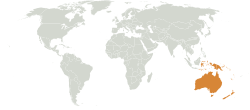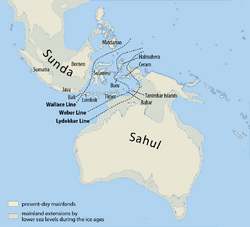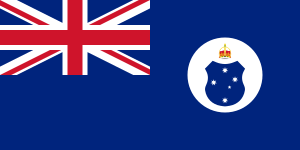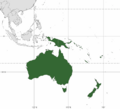Australasia facts for kids

Australasia is a large region in the world. It's special because of its shared natural history and geology. This area was once part of a huge ancient continent called Gondwana. It includes the Australasian ecozone, which is a region with similar plants and animals.
Australasia's islands are all found southeast of a special line called the Wallace Line. This line is named after Alfred Russel Wallace, who studied animals there. The main countries and islands in Australasia are:
- Australia
- New Zealand
- New Guinea (which includes Papua New Guinea and parts of Indonesia)
- Melanesia (many islands in the Pacific Ocean)
- Flores
- Lombok
- New Caledonia
- Sulawesi
- Sumbawa
- Tasmania
- Timor
Australasia is part of a bigger region called Oceania.
What is Australasia?
Australasia usually includes New Zealand, Australia (with Tasmania), and Melanesia. Melanesia includes Papua New Guinea and other islands north and east of Australia in the Pacific Ocean. Sometimes, the term Australasia is used for all the lands and islands in the Pacific Ocean between the equator and 47° south. Papua New Guinea alone has about 600 smaller islands!
Most of Australasia sits on the southern part of a large tectonic plate called the Indo-Australian Plate. The Indian Ocean is to its west, and the Southern Ocean is to its south. Some areas are on other plates, like the Eurasian Plate to the northwest or the Pacific Plate to the north and east.
Australasia and People
When people talk about Australasia in terms of countries, they often mean just Australia and New Zealand. This is because there isn't another common word for these two countries together. Sometimes, the island of New Guinea is also included. Many groups, like sports clubs or scientific societies, use "Australasian" in their name to show they cover both Australia and New Zealand.
In the past, Australia and New Zealand even teamed up for sports! They competed together as "Australasia" in tennis for the Davis Cup between 1905 and 1915. They also formed a combined team for the Olympic Games in 1908 and 1912.
Experts who study human history believe that the first people to live on the islands of Australasia came from Southeast Asia. It's thought that the first humans arrived in Australia over 50,000 years ago. These people were the ancestors of today's Aboriginal Australians. They were mostly hunter-gatherers and traveled to Australia using land bridges and short sea trips from what is now Southeast Asia.
Images for kids
-
Regions of Oceania
-
Australia's idea of Australasia, which includes Australia, New Zealand and Melanesia
See also
 In Spanish: Australasia para niños
In Spanish: Australasia para niños






